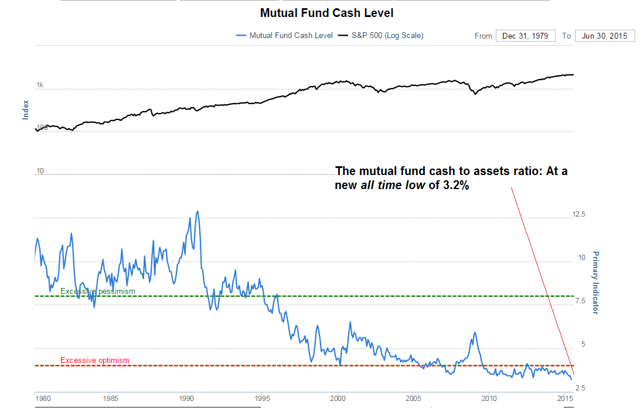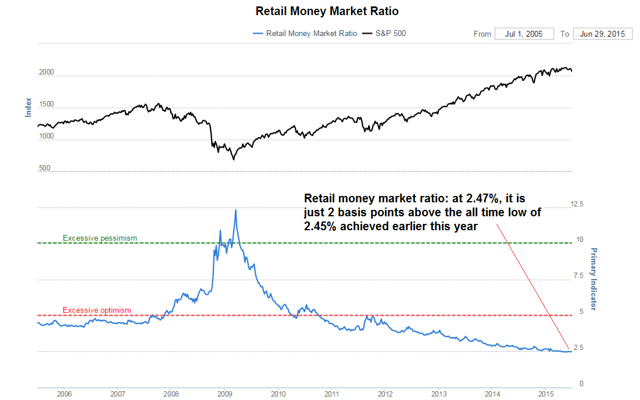Scalper1 News

 By Pater Tenebrarum Another Ominous Record is Set We have frequently mentioned the mutual fund cash-to-assets ratio in these pages, mainly because it has never been as persistently low as in recent years. At the beginning of the secular bull market in the early 1980s, it routinely inhabited the exact opposite end of the spectrum. Back then, mutual fund managers were scared of losing their clients’ money in the stock market. Today they seem only afraid of missing the next rally. Given that the indicator isn’t of short-term significance, it doesn’t need to be updated all the time, but something has just happened that gives us a good reason to report on it again. The ratio has just declined to a new all time low of just 3.2%. (click to enlarge) Mutual fund cash levels: at a new all time low of 3.2% In short, as a group, mutual fund managers have never been more thoroughly exposed to the stock market than today. Our guess is that they actually don’t “hate the market” (a story often regurgitated in the media is how “hated” the current bubble allegedly is). Along similar lines, the retail money market ratio (the ratio of retail money market funds to stock market capitalization as represented by the S&P 500 Index) sits at a mere 2.47% – just 2 basis points above the all time low made earlier this year. The reason why it has risen by 0.02% is not that retail investors have become more cautious – the reason is that the market’s capitalization has declined ever so slightly, with slightly less than half of the stocks in the S&P 500 trading below their 200-day moving averages (see also the discussion of market internals in our recent missive ” The US Stock Market and a Major Recession Warning “). (click to enlarge) The retail money market ratio: retail money market fund assets as a percentage of the market capitalization of the S&P 500. Conclusion The market has a problem that is widely ignored – sentiment is actually extremely lopsided as positioning data like those shown above indicate. The biggest source of buying power appear to be stock buybacks by listed companies these days. However, the margins of these companies have up until recently been at the very top of their historical range – they can probably only get worse from here. A few large companies (such as e.g. IBM) have already been forced to announce cutbacks to their share repurchase programs due to sharp revenue and earnings declines and their ever larger debt loads. Margin debt meanwhile remains close to an all time high. If prices begin to decline, who is going to buy? Share this article with a colleague Scalper1 News
By Pater Tenebrarum Another Ominous Record is Set We have frequently mentioned the mutual fund cash-to-assets ratio in these pages, mainly because it has never been as persistently low as in recent years. At the beginning of the secular bull market in the early 1980s, it routinely inhabited the exact opposite end of the spectrum. Back then, mutual fund managers were scared of losing their clients’ money in the stock market. Today they seem only afraid of missing the next rally. Given that the indicator isn’t of short-term significance, it doesn’t need to be updated all the time, but something has just happened that gives us a good reason to report on it again. The ratio has just declined to a new all time low of just 3.2%. (click to enlarge) Mutual fund cash levels: at a new all time low of 3.2% In short, as a group, mutual fund managers have never been more thoroughly exposed to the stock market than today. Our guess is that they actually don’t “hate the market” (a story often regurgitated in the media is how “hated” the current bubble allegedly is). Along similar lines, the retail money market ratio (the ratio of retail money market funds to stock market capitalization as represented by the S&P 500 Index) sits at a mere 2.47% – just 2 basis points above the all time low made earlier this year. The reason why it has risen by 0.02% is not that retail investors have become more cautious – the reason is that the market’s capitalization has declined ever so slightly, with slightly less than half of the stocks in the S&P 500 trading below their 200-day moving averages (see also the discussion of market internals in our recent missive ” The US Stock Market and a Major Recession Warning “). (click to enlarge) The retail money market ratio: retail money market fund assets as a percentage of the market capitalization of the S&P 500. Conclusion The market has a problem that is widely ignored – sentiment is actually extremely lopsided as positioning data like those shown above indicate. The biggest source of buying power appear to be stock buybacks by listed companies these days. However, the margins of these companies have up until recently been at the very top of their historical range – they can probably only get worse from here. A few large companies (such as e.g. IBM) have already been forced to announce cutbacks to their share repurchase programs due to sharp revenue and earnings declines and their ever larger debt loads. Margin debt meanwhile remains close to an all time high. If prices begin to decline, who is going to buy? Share this article with a colleague Scalper1 News
Scalper1 News